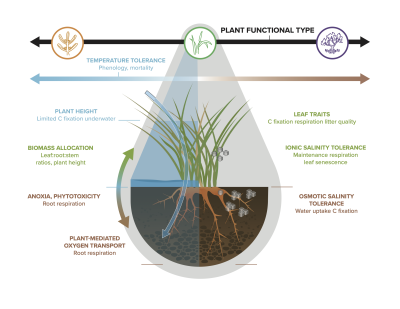A Roadmap for Improving Models of Coastal Wetland Vegetation
Coastal wetlands are subject to fluctuations in salinity and water levels and are home to specialized plant species that can sequester carbon at high rates. This study synthesized information about plant types and environmental controls in coastal wetlands and suggests that including specific vegetation types (salt marsh, mangrove, and succulent) and their different responses to salinity and water levels can improve land model simulations of carbon storage and greenhouse gas balance of coastal regions.
Coastal wetland ecosystems can store carbon at very high rates, but are not well represented in current land models, meaning that model simulations could underestimate ecosystem carbon sequestration in coastal regions. Improving how coastal vegetation is simulated in these models is an important step toward improved predictions of coastal wetland carbon sequestration and other ecosystem services, as well as the vulnerability of coastal wetlands to sea level rise and other stressors.
Coastal wetlands are poorly represented in land surface models, even though these ecosystems can sequester carbon at very high rates. Incorporating coastal wetland vegetation into land models could therefore improve simulations of carbon sequestration and related ecosystem services in coastal regions. This study identifies guiding questions, simulation strategies, and data needs for improving model representation of vegetation in coastal and estuarine ecosystems. Models could improve the representation of coastal wetlands by including separate plant functional types for mangroves, graminoid salt marshes, and succulent salt marshes to adequately represent the variations in productivity as well as above- and below-ground partitioning of biomass across vegetation types. Coastal vegetation types also represent a broad range of tolerances and adaptations to fluctuations in salinity and water level, which drive key gradients in coastal wetland ecosystems. Shifts in dominant plant functional types driven by shifts in water levels, climate, and salinity could have significant consequences for carbon storage due to the substantial differences in biomass and growth patterns across coastal wetland plant types.

